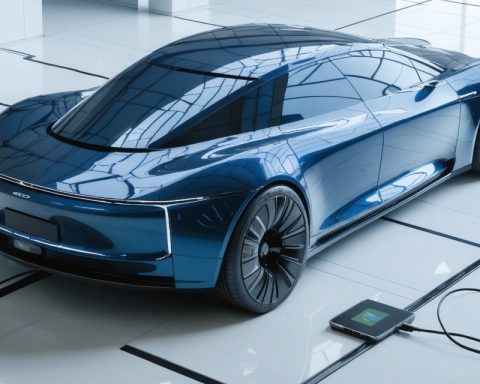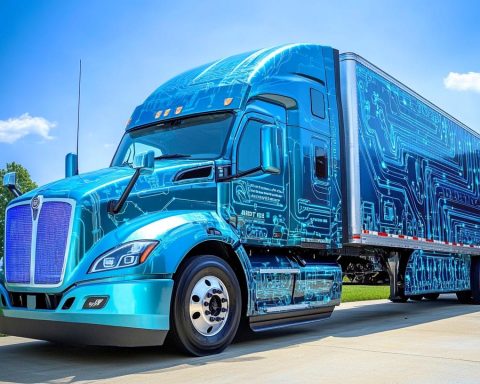- The iron-sodium battery emerges as a revolutionary alternative to lithium-ion technology, offering long-duration energy storage solutions.
- Inlyte, an American startup, is at the forefront with an innovative battery expected to last over 7,000 cycles, potentially operating for around 20 years.
- This new battery technology is more affordable and sustainable compared to traditional systems.
- Inlyte plans to open “Inlyte Factory 1” by 2027, with support from Swiss partner HORIEN Salt Battery Solutions.
- Tesla remains a key player with its Megapacks, recently expanding manufacturing capabilities in Shanghai.
- The evolving battery landscape is driven by the need for more than 10-hour storage, pivotal for solar and renewable energy grids.
Amidst sprawling progress in renewable energy, a silent revolution in battery technology is challenging giants in the industry—and it’s not lithium-based. Historically spearheaded by Tesla with their enormous Megapack systems, the race for long-duration energy storage now includes a formidable contender: the iron-sodium battery, poised to redefine storage capabilities and sustainability.
Picture the sprawling grids and myriad solar power arrays inching across our landscapes and rooftops. As they soak up the sun, their excess energy demands safe haven—a place to wait until it’s needed by a world hungry for clean power, even after the sun dips below the horizon. Traditionally, lithium-ion batteries have commanded this battlefield, enduring for about four hours before requiring a recharge, a feat that has positioned them heroically thus far. However, the winds are shifting, and as energy planners strive for a future where storage must last over 10 hours, alternatives emerge from the woodwork.
Enter Inlyte, a spirited American startup, forging a beacon of hope with their innovative iron-sodium battery. This breakthrough promises an operational lifespan of at least 7,000 cycles, translating to an astonishing two decades of functionality—rivaling the costly incumbents, yet poised at a fraction of the price. Partnering with Switzerland’s HORIEN Salt Battery Solutions, Inlyte engineers a path of accelerated usage for their technology by tapping into vast manufacturing expertise.
Given its recent successful pilot in the UK, Inlyte charts a bold course across the Atlantic. With ambitions set towards launching “Inlyte Factory 1” by 2027, their vision aligns snugly with federal energy initiatives targeting a greener tomorrow, though the exact location remains under wraps.
Meanwhile, seismic developments unfold in Eastern cities where Tesla’s colossal Megapacks set sail from a recently inaugurated Shanghai Megafactory. Capable of storing enough energy to power 62 Tesla Model 3s, these mammoth batteries stand as testament to Tesla’s prowess in the global energy sector—a dual endeavor that mirrors their automotive triumphs.
As the dust of competition swirls, the iron-sodium battery stands ready to challenge incumbents by combining affordability with sustainability. If realization follows ambition, Inlyte’s bold venture could recast the landscape of clean energy storage with promising new horizons.
Ironic Evolution: How Iron-Sodium Batteries are Powering the Future of Energy Storage
In recent years, the surge in renewable energy has illuminated the potential of battery technology to significantly transform power storage solutions. This revolution is no longer dominated solely by lithium-ion batteries; a new contender, the iron-sodium battery, is stepping into the limelight with remarkable benefits that echo both sustainability and economic practicality.
Key Features of Iron-Sodium Batteries
Extended Lifespan:
Iron-sodium batteries boast an impressive operational lifespan of over 7,000 cycles, equating to about 20 years of functionality. This far exceeds traditional lithium-ion counterparts, which typically need replacement after 3,000 to 5,000 cycles. This longevity translates to reduced maintenance costs and improved sustainability.
Cost Efficiency:
Iron-sodium batteries are projected to be significantly more cost-effective than lithium alternatives. This affordability arises from the use of abundant materials like iron and sodium, which contrasts sharply with the scarcity and high processing costs associated with lithium and cobalt—the latter raising ethical and environmental concerns.
Environmental Impact:
Iron-sodium technology is notably more environmentally friendly. Sodium and iron are far more abundant than lithium, eliminating the need for environmentally damaging mining practices. Furthermore, the recyclability of these materials adds to their green credentials.
How Iron-Sodium Batteries Work
Iron-sodium batteries operate by utilizing electrodes made primarily of iron and sodium ions for electron exchange. The ions move between the electrodes during charging and discharging, similar to the mechanism in lithium-ion batteries. However, the stability and abundance of these components offer superior safety, significantly reducing the risk of overheating and fires.
Real-World Use Cases and Industry Trends
Grid Storage:
Iron-sodium batteries are particularly promising for grid applications where long-duration storage is crucial. Their ability to store energy for over 10 hours makes them ideal for balancing intermittent renewable energy sources like wind and solar, ensuring consistency in power supply.
Renewable Integration:
With growing global pressure towards renewable adoption, these batteries could facilitate the expansion of solar and wind farms by providing reliable storage solutions. They enable energy providers to stabilize output even when solar generation dips at night or wind patterns fluctuate.
Market Growth:
The iron-sodium battery market is poised for expansion, driven by advancements in technology and increased investment in renewable energy infrastructure. According to industry forecasts, the energy storage market is expected to grow from $15 billion in 2020 to over $60 billion by 2030, with iron-sodium playing a pivotal role.
Industry Comparisons
When compared to Tesla’s Megapack systems, iron-sodium batteries offer prolonged durations at a lower cost, challenging the status quo dominated by lithium-ion technologies. Tesla’s focus has been more on large-scale installations, whereas companies like Inlyte aim at scalable solutions across various sectors.
Controversies and Limitations
Technical Challenges:
Despite their advantages, iron-sodium batteries face challenges in energy density, where lithium-ion retains an edge. Research and development are essential to improve this aspect to make them more competitive in applications like electric vehicles where space and weight constraints exist.
Market Penetration:
The current market dominance of lithium-ion technology, along with established supply chains, presents a barrier for iron-sodium technologies. Overcoming these requires robust marketing strategies and proven real-world applications to gain trust and market share.
Quick Tips and Recommendations
– For Investors: Keep an eye on emerging companies like Inlyte and monitor developments in the iron-sodium sector. Investing early could yield substantial returns as the market begins to scale.
– For Energy Providers: Consider integrating iron-sodium storage solutions to reduce costs and align with sustainability goals.
– For Policymakers: Supportive policies and incentives for iron-sodium batteries could accelerate adoption and help meet emission reduction targets.
Further Reading
Explore more about innovative energy storage solutions and their impact on future sustainability by visiting Tesla and Schneider Electric.
As we look to a future powered by clean energy, the iron-sodium battery stands poised to redefine the energy landscape. With continued innovations and supportive policies, this technology may well lead the charge in sustainable and economical energy storage.















